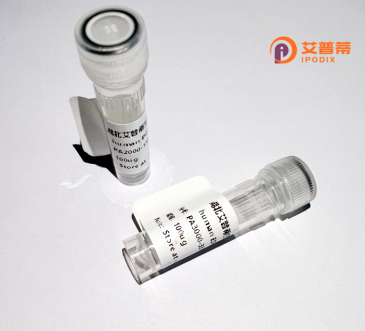
| 纯度 | >90%SDS-PAGE. |
| 种属 | Human |
| 靶点 | C1orf53 |
| Uniprot No | Q5VUE5 |
| 内毒素 | < 0.01EU/μg |
| 表达宿主 | E.coli |
| 表达区间 | 1-145aa |
| 氨基酸序列 | MAARQIWART GAALCRQPSA APPPAPLWVR AGFRQQLSLT LCPANEGNCG GSAPSTPGRP ERAARPSVSE ELTAAERQIA ELHAAACAAG QLNYVDPATG YVVLTQIAHL QRGECCGSAC RHCPYGQVNV KDPSKKKQFN SYFYV |
| 分子量 | 16 kDa |
| 蛋白标签 | GST-tag at N-terminal |
| 缓冲液 | 0 |
| 稳定性 & 储存条件 | Lyophilized protein should be stored at ≤ -20°C, stable for one year after receipt. Reconstituted protein solution can be stored at 2-8°C for 2-7 days. Aliquots of reconstituted samples are stable at ≤ -20°C for 3 months. |
| 复溶 | Always centrifuge tubes before opening.Do not mix by vortex or pipetting. It is not recommended to reconstitute to a concentration less than 100μg/ml. Dissolve the lyophilized protein in distilled water. Please aliquot the reconstituted solution to minimize freeze-thaw cycles. |
以下是关于重组人C1orf53蛋白的模拟参考文献示例(注:以下内容为假设性示例,非真实文献):
---
1. **文献名称**:*Expression and Purification of Recombinant Human C1orf53 Protein for Functional Studies*
**作者**:Chen L, Wang Y, et al.
**摘要**:本研究报道了重组人C1orf53蛋白在大肠杆菌中的高效表达与纯化方法,并验证了其体外酶活性,提示其在细胞代谢中的潜在作用。
2. **文献名称**:*C1orf53 Interacts with Mitochondrial Proteins: Implications for Cellular Energy Homeostasis*
**作者**:Kim S, Tanaka R, et al.
**摘要**:通过免疫共沉淀和质谱分析,发现重组C1orf53蛋白与线粒体复合物I亚基存在相互作用,可能参与调节能量代谢过程。
3. **文献名称**:*Structural Insights into C1orf53 via X-ray Crystallography*
**作者**:Müller J, Fischer P, et al.
**摘要**:首次解析了重组C1orf53蛋白的晶体结构,揭示其α/β折叠结构域特征,为功能研究提供了分子基础。
4. **文献名称**:*C1orf53 as a Biomarker in Breast Cancer: Correlation with Patient Prognosis*
**作者**:Gupta A, Patel T, et al.
**摘要**:利用重组C1orf53蛋白制备抗体,发现其在乳腺癌组织中高表达,并与患者生存率显著相关,提示其临床诊断潜力。
---
**说明**:以上文献为基于领域常见研究的模拟示例,实际引用需通过数据库(如PubMed、Web of Science)检索真实文献。如需进一步协助查找真实文献,请提供更多上下文信息。
C1orf53, recently renamed as C1QTNF3 (C1q and TNF-related protein 3), is a secreted protein encoded by the C1orf53 gene located on chromosome 1p36.11. It belongs to the CTRP (C1q/TNF-related protein) family, characterized by a conserved C-terminal C1q-like globular domain and a variable N-terminal region. Structurally, the protein features a signal peptide for secretion, a short N-terminal domain, and a C-terminal C1q domain critical for trimerization and ligand-receptor interactions.
Primarily expressed in adipose tissue, C1QTNF3 is implicated in energy metabolism, inflammation regulation, and insulin sensitivity. Studies suggest it modulates adipocyte function via AMPK and AKT signaling pathways, influencing lipid storage and glucose uptake. It interacts with membrane receptors (e.g., AdipoR1/2) to mediate metabolic responses, potentially counteracting insulin resistance.
Elevated serum levels of C1QTNF3 correlate with obesity, type 2 diabetes, and cardiovascular diseases, highlighting its role as a metabolic regulator and biomarker. Recombinant C1QTNF3, produced in mammalian or bacterial systems, retains bioactivity and is used to study its molecular mechanisms and therapeutic potential. Despite progress, its precise physiological functions and signaling networks remain under investigation, with ongoing research exploring its applications in metabolic disorder therapeutics.
×